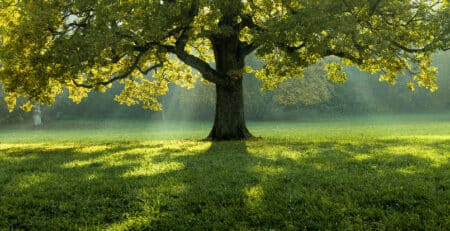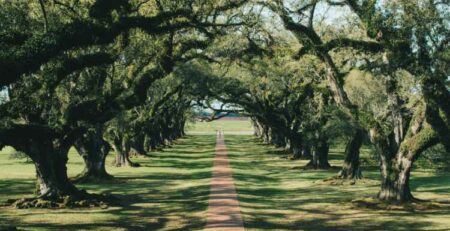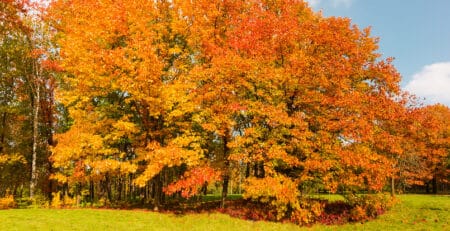5 Differences Between Trees vs Shrubs
Trees and shrubs are both members of the Plantae kingdom, but they have unique characteristics that differentiate them from other types of plants. In this guide, we’ll take a closer look at the differences between trees and shrubs, highlighting five key points.
 Introduction
Introduction
Trees and shrubs are types of plants, which have distinctive characteristics that make them different from other species. While shrubs and trees share similarities, it is important to understand that there are differences. Here are 5 key differences to keep an eye out for when comparing trees to shrubs.
Trees vs shrubs: The main differences
1. Trunks vs stems
Perhaps the most significant difference between shrubs and trees is the supporting structure. While a tree boasts a strong, robust central trunk, shrubs have multiple stems.
The tree trunk is a fascinating structure, which has a diverse range of important functions and purposes. Firstly, the trunk provides stability and support for the tree. Trees tend to grow very tall and the trunk protects against the elements, anchoring the tree into the ground. Secondly, the trunk is comparable to a plumbing system, which is responsible for transporting and delivering water and essential nutrients. The trunk is also an essential shield. Trees produce bark, which acts as a barrier in a similar way to human skin. The bark lowers the risk of disease at the same time as preventing moisture from escaping. Most of the tree trunk comprises dead tissue. The primary role of this dead tissue is to support the weight of the canopy. Without a sturdy trunk, the tree would bend in the wind, branches would crack and break and leaves would fall.
Shrubs differ from trees because they do not have a single stem. Shrubs have multiple stems, which tend to be narrow. Unlike tree trunks, which stretch high into the sky, shrubs lie close to the ground. Shrubs stems are less rigid and dense than trunks and stems usually measure no more than 3cm in diameter.
2. Height and size
One of the most distinctive differences between trees and shrubs is the difference in height and size. There are exceptions to the rules, but typically, trees are a lot larger than shrubs. If you were to draw a picture of a tree and a shrub, it’s likely that the tree would be a lot bigger and taller than the shrub. Shrubs tend to grow close to the ground and they rarely reach more than 13 feet, while trees can grow to over 100 feet tall. The Guinness Book of World Records states that the world’s tallest tree, a redwood located in California’s Redwood National Park, stands at 116 metres (380 feet).
Some trees are much taller than others and height will vary, according to species and environmental conditions. To reach optimum height for their species, trees and shrubs need access to water, sunlight and air. Trees generally measure over 13 feet when mature, while the majority of shrubs will be much shorter than 13 feet.
While trees continue to grow, climbing towards the skies, shrubs prefer to stay close to ground level. We often see rockeries and rock gardens, as well as forest floors covered in low-lying shrubs.
3. Uses and functions
Both trees and shrubs offer humans a diverse range of opportunities, but there are differences in how we use different types of plants.
Trees are among the most versatile plants and we use them for a whole host of purposes. We have used wood to build and create shelters, houses and buildings for centuries and wood is still one of the most commonly used building materials. We also use wood to make furniture, decorative accessories and flooring. We use trees to produce paper and to generate fuel to keep our homes warm. Many species of trees also produce fruits, which we use in cooking and food preparation.
Shrubs also boast an impressive array of functions. We can use shrubs for lumber and fuel and they also play an important role in food and drink production.
Gardeners and landscapers use both trees and shrubs in landscaping and design. We plant trees and place shrubs and plants to create beautiful gardens and green spaces. The aesthetic appeal is clear, but planting and tending to plants can also have benefits for health and wellbeing. Research suggests that people feel happier and less stressed when they spend time outdoors surrounded by greenery. In offices and workplaces, having plants in close proximity can also boost productivity levels and enhance wellbeing.
Environmental impact is another important function. Shrubs and trees provide habitats and homes for animals and wildlife. Shrubs can also help to reduce the risk of soil erosion and flooding and trees absorb vast amounts of carbon dioxide, providing us with oxygen-rich air.
4. Lifespan
Shrubs are hardy plants, which are famed for their ability to withstand the elements and survive harsh winters, but they cannot compete with trees in terms of life expectancy. It is uncommon for shrubs to live for longer than 15 years, while trees can live for hundreds, even thousands of years.
Shrubs last longer than many other types of plants, but trees are known for their impressive lifespans. Shrubs and trees are usually classed as perennials because they live for longer than five years. Trees have adapted to utilise intelligent survival tactics to stand the test of time. Due to their proximity to the ground and their weaker, narrower stems, shrubs are more vulnerable to predators and the effects of changing weather conditions.
When talking about the projected lifespan of trees and shrubs, it’s important to note that the type of plant and the species of shrub or tree are not the only factors that impact longevity. The conditions and the environment will also influence durability. Factors that are likely to endanger growth and limit life expectancy include:
- Disease: the presence or spread of disease can affect shrubs and trees, reducing their lifespan.
- Stress: human activity, traffic, intense heat and pollution can all take their toll on trees and shrubs.
- Shade vs sun: shrubs have different needs and preferences when it comes to the location of planting. Some love to be bathed in sunlight, while others prefer shady spots. If you are planting shrubs, it’s important to ensure that you choose a suitable patch.
- Weather: the weather conditions can affect plants of all types. While some may thrive in sunlight and heat, others struggle to deal with rising temperatures. Similarly, some trees and shrubs prefer shade and cooler climates.
- Moisture: trees and shrubs need water to survive, but some require more than others. There are species of shrubs and trees that have adapted to thrive in arid areas, but many prefer moist environments.
When planting trees or shrubs or taking over a garden that already has mature trees and shrubs, it’s beneficial to consider the different types of plants you have to ensure you provide the best possible conditions.
5. Distinctive heads
When comparing shrubs and trees, there are often visible differences. In addition to the obvious height difference between trees and shrubs and the presence of a single trunk versus multiple stems, there is another common observation. In most cases, trees have a distinctive head. When you look at a tree, there is usually a visible peak in the canopy and a clear shape to the leaves and branches. Most trees have a central trunk, which expands into a network of large branches, which are connected to smaller branches and twigs adorned with leaves. The shape of trees varies hugely according to the species. Firs, for example, look very different from oak trees and willows.
In contrast to the distinguished head of the tree, shrubs have a more fluid form and they often grow in bunches to cover vast areas in greenery and flashes of colour. Keen gardeners and landscapers may be keen to trim and prune shrubs to reshape them for enhanced aesthetic appeal.
Summary
Trees and shrubs are both types of plants, which belong to the Plantae kingdom. Although there are many similarities between shrubs and trees, there are also some key differences. Trees have a single, central trunk, which tends to be robust, sturdy and strong. Shrubs have a number of smaller, narrower stems. Typically, trees are much taller than shrubs and they live longer. It is not uncommon to find trees that are hundreds of years old or to spot trees that are over 50 metres tall. Shrubs have an average lifespan of up to 15 years and they are usually located close to the ground with a maximum height of around 13 feet. Both trees and shrubs are versatile and useful. As well as using them to create beautiful, tranquil green spaces, we use trees to make furniture, construct buildings, make paper and generate fuel. Shrubs and trees provide habitats for wildlife and we also use them in food and drink production. Trees and shrubs come in a range of shapes and sizes, but in most cases, trees have a distinctive head.







